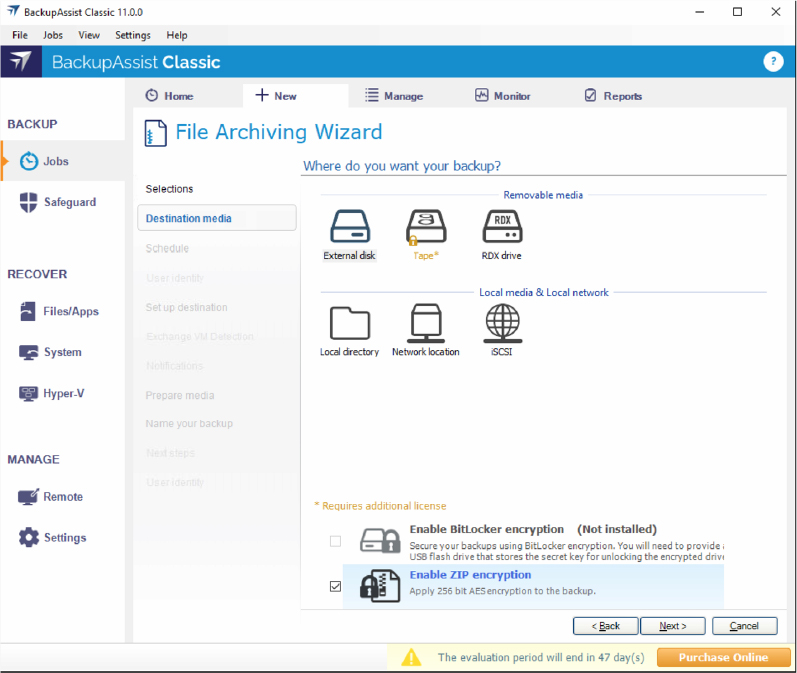
How multiple layers of backups will slash data loss, enable fast recovery and give the best cyber-resilience.
With support for system image backup, file backup, and application backup (Exchange, Hyper-V and SQL), we make it easy.
-
Backup Capabilities
◆◆◆
Technical Deep DiveLong gone are the days when having a image backup was sufficient. Yes, you need a bare metal backup for system recovery... but that's only the start.
With so many hackers targeting your systems and your backups, what you need are multiple layers of protection.
BackupAssist Classic provides onsite, offsite, online and offline backups including system drive images, and application & file backups. This gives you multiple recovery options when you need them the most. Back up to USB disk, NAS, iSCSI, cloud - it's easy to be cyber-resilient and never pay a ransom!
We provide multiple types of backups, customizable to solve your cyber-resilience goals.
- Windows Image Backups: to hard drive, NAS, RDX and iSCSI - for fast system recovery
- File backups to the cloud: to Azure, AWS S3, Wasabi, or any S3 enabled cloud / NAS
- File backups to local NAS/iSCSI: for extensive version history
- Archival backups: for long-term compliance and recordkeeping to disk or tape
Easily achieve a comprehensive backup system.
- A mixture of onsite, offsite, online and offline backups.
- Easily store multiple backups in multiple locations.
- Each backup is independent of each other, giving you multiple layers of fallback and options for recovery.
Faster recovery times while slashing data loss.
It's always better to have several good recovery options in case some go bad.
BackupAssist Classic gives you these options. With the correct setup, there's no way anyone should lose all their data or pay a hefty ransom.
The result: successful recovery.
Most backup software products are a “one trick pony”, offering just one type of backup. Generally they only give you two options.
- One type of backup to one place (local or cloud).
OR
- One type of backup to a local destination, then replicated offsite.
The problem is, no single backup can do everything and be resilient to all potential disasters. Each type of backup (image backup, file backup, etc) has strengths and weaknesses, which you might not realize until it's too late.
Now, in the age of cyber crime, hackers are exploiting these weaknesses to hold businesses and government departments to ransom.
They thought they were “smart” by optimizing or streamlining their backups by putting all data online in a single cloud, simplifying the setup using a single sign-on, or relying on cloud replication for geo-redundancy.
This inadvertently gave cyber criminals a single point for attack, and robbed the administrators of recovery options.
The result: permanent data loss / ransom
OVERVIEW OF BACKUP TYPES
Welcome to our five "backup engines" - the building blocks for success.
Firstly, let's introduce our five backup options, and the role they play in building a customized cyber-resilience strategy that's right for your organisation.

System Protection
(Windows image backup)
A system image of your hard drive - operating system and data, preparing you for a full server recovery if you lost everything.
Recommended for essential cyber-resilience

Cloud Offsite
(File backups)
Fully automated offsite file backups designed to complement drive imaging, to achieve additional recovery options in the event of a cyber attack, hardware failure or natural disaster.
Recommended for essential cyber-resilience

File Replication
(File replication)
A replica of your file system, updated daily onto a different storage device. Can provide huge amounts of version history, and point-in-time restores, and extra recovery options in a disaster recovery situation.
Provides enhanced cyber-resilience and rich file versioning

File Archiving
(File backup to ZIP)
A snapshot of your file system at the time of the backup. Each ZIP file is complete and fully independent. Designed to be put into archives, for long term “system of record” and data retention.
Provides enhanced cyber-resilience and meets legal compliance

SQL Backups
Additional backups for SQL Server designed to reduce the window of possible data loss down to just a few minutes.
Provides enhanced cyber-resilience and reduces data loss
Now, let's see how we use these different backup engines to good effect.
WHAT'S IN IT FOR YOU
Using the five backup engines in the right combination gives you advantages that no other Windows backup software package can offer.

It meets the requirements for robust cyber-resilience - onsite, offsite, online, offline backups.

It provides optimal solutions for business continuity, file versioning and long term data retention.

Using multiple backup engines will slash your window of data loss while making recovery faster.

It provides long term data accessibility.
Let's delve in further.
1. A comprehensive cyber-resilience strategy with BackupAssist Classic gives multiple recovery options in each of the three major emergency situations.
How would you respond in each emergency? Open the sections below to discover what your recovery options are.
As you can see above, this means you need a combination of onsite, offsite, and offline backups. BackupAssist Classic does it all, providing options for each:
| For… | Keep | Use this type of backup | Safest destinations |
|---|---|---|---|
| Fast recovery | Onsite backup (Stored on-premises) |
Advanced image backup | > USB HDD or RDX > NAS |
| Recovery if premises are destroyed | Offsite backup (Stored at a different physical location) |
> Advanced image backup > File protection > Cloud offsite file backup |
> USB HDD or RDX, swapped offsite > USB HDD or RDX, swapped offsite > Azure / AWS S3 / Wasabi / S3 compatible cloud / NAS |
| Recovery if cyber attacked | Offline backup (Disconnected from the Internet / LAN) |
> Advanced image backup > File protection |
> USB HDD or RDX, swapped offsite > USB HDD or RDX, swapped offsite |
2. BackupAssist Classic gives you optimal solutions for business continuity, file versioning and system of record (long term data retention).
| For… | Use this type of backup | Example destinations |
|---|---|---|
| Business continuity | System protection (Advanced image backup) | > USB HDD or RDX > NAS |
| File versioning | > File protection (replication) > Files to cloud offsite |
> NAS > Azure / AWS S3 / Wasabi / S3 compatible cloud / NAS |
| System of record / long term data retention | File archiving (ZIP) | > Disk > Tape |
3. Using multiple backup jobs improves recovery times while reducing data loss.
Unfortunately, theres no single “perfect” backup. In fact, each type of backup has its own “Achilles Heel”… but combining different backup types together will give you a much more resilient system with fast recovery (RTO) and small window of data loss (RPO).
Here are some issues with individual types of backups.
| Type of Backup | Strengths & benefits | Weaknesses |
|---|---|---|
| System Protection (Advanced image backup) | Fastest way to recover a server. | If backup is online (NAS, iSCSI), it is vulnerable to hacking. If backup is onsite, it is vulnerable to premises destruction. Taking the backup offsite and offline requires manual human intervention. Generally, you need to back up your entire system, so the backups are generally large. |
| Cloud offsite | Automatic offsite backups without human intervention. | Downloading large amounts of data from a public or private cloud can be slow. |
| File Protection (file replication) | Massive amounts of version history. You can selectively protect parts of the file system, saving on backup storage space. |
Not suitable for a full system recovery. |
| File Archiving (backup to ZIP) | Fantastic for long term data retention. | Not suitable for a full system recovery |
| SQL backups | Near continuous protection for SQL Server | Only backs up to local directory on SQL Server |
However, when you start to combine these engines together and perform multiple backups, you improve recovery times, reduce the window of data loss, and improve your overall cyber-resilience. Here one example.
Combining Advanced Image backup and Cloud offsite backup to reduce window of data loss, retaining fast recovery.
Acme company performs a System Protection (Advanced image backup) job nightly at 10pm, to a set of USB hard disks. These disks get swapped offsite daily.
Their building burns down on Wednesday at 2am. This is the worst case - they have to recover from the last offsite backup, which was done on Monday at 10pm. They lost all work since Monday 10pm - a total of 28 hours, including all of Tuesday's work.
However, Acme II company (in the same building) does 2 backups - the same as described above, and they also do a Cloud Offsite backup to back up their files. And they do this backup every 6 hours (12am, 6am, 12pm, 6pm). Now the only lose 2 hours of work.
Acme II will do this for their recovery:
- Bare metal recovery of entire system from Monday night's Advanced image backup
- Differential restore from the cloud - only downloading the changes between the last backup (Wednesday 12am) and Monday 10pm.
Therefore - the recovery is fast, window of data loss is reduced.
4. BackupAssist Classic provides long term data retrievability from backup.
An important property of a good backup is whether you can retrieve data from the backup without needing any special software. For most backup types offered in BackupAssist Classic, the answer to that is 'yes'.
| Type of Backup | Data Format | Long term retrievable without BackupAssist? |
|---|---|---|
| Drive imaging (Advanced image backup) | VHDX | Yes |
| File replication | Files, same as original | Yes |
| Cloud offsite | Deduplicated, compressed, encrypted chunks | No* |
| ZIP backups | ZIP64 format | Yes |
| SQL backups | SQL Server native format | Yes |
* Cloud offsite backups are stored in our proprietary format because there is no industry standard data format that is suitable. All other backups are stored in open, open-source or ubiquitous file formats.
HOW IT WORKS
Each backup engine provides specific protection for your Windows environment. Here are detailed technical details of each of our backup engines:
FREQUENTLY ASKED QUESTIONS
We hear your pain… if you're just starting off preparing for cyber-resilience, it can seem daunting to have to set up multiple backups all at once.
We recommend that you start with one backup type - system protection - to get a advanced image backup for essential cyber-resilience, and build from there.
This is the type of backup that helps you recover the entire system, all configurations, applications and data, in a single backup. From this single backup, you can recover from many different scenarios. This makes it a very versatile backup.
- Rebuild your entire server.
- Restore VSS applications (Exchange, Hyper-V, SQL Server).
- Restore files.
- The drive image files can become very large if your system is large. There is one backup file (VHDX file format) per volume on your system.
- Large drive images are not suitable for uploading to the cloud. A file backup solution is more suited to this.
A file backup, or file-based backup, is a completely different technology that backs up file-by-file. This is generally slower than an image backup, but has advantages because it backs up at a very granular level.
A good file backup engine will not only back up the file contents, but the metadata for each file. The metadata includes the timestamps (created, modified, accessed), attributes such as read-only, and Access Control Lists. This means when you restore a file, all metadata associated with that file is also restored.
BackupAssist Classic's file backup engines will correctly back up and restore both file contents and metadata.







